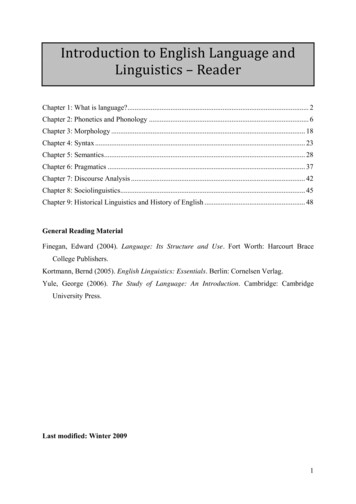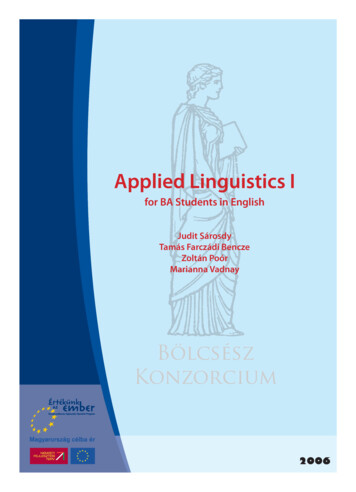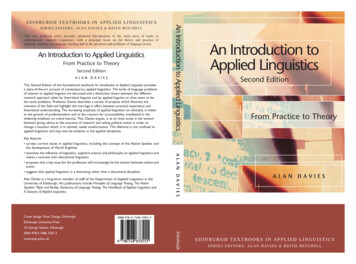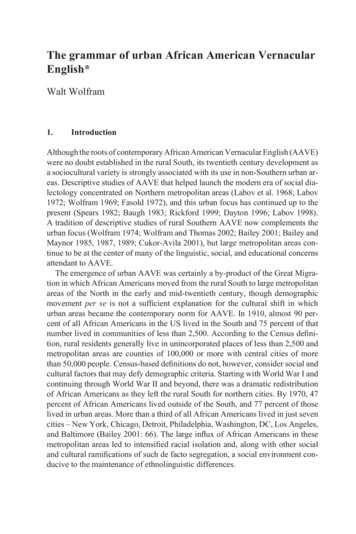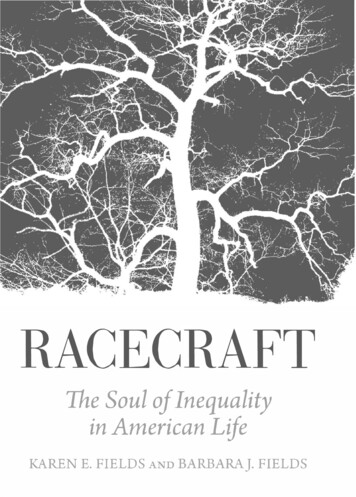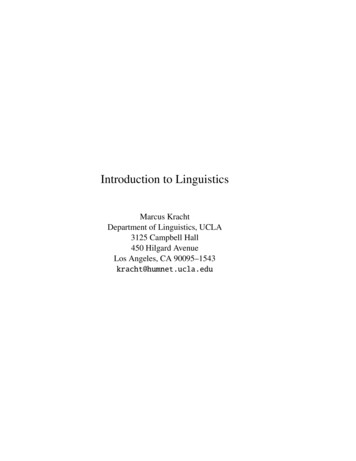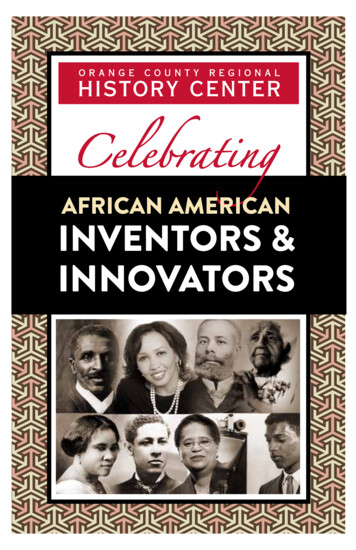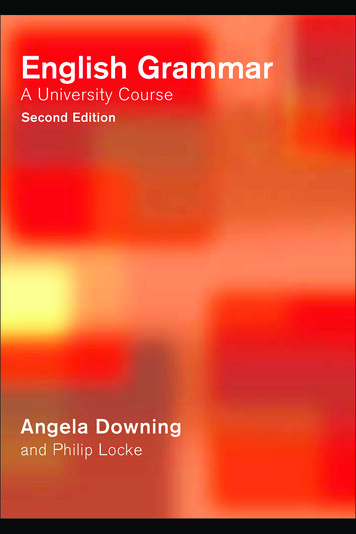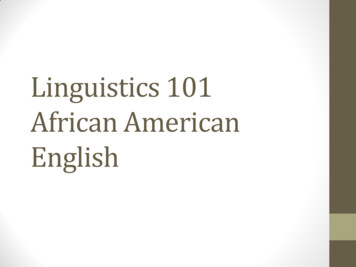
Transcription
Linguistics 101African AmericanEnglish
AAE - Basics AAE AAVE (African American Vernacular English) AAE is a dialect continuum ranges from Standard American English spoken with a AAE accentto the Gullah creole like that spoken off the coast of Georgia. AAE is neither spoken by all African Americans, nor is it spokenby only African Americans. Most speakers of AAE are bidialectal.
AAE - Basics Why focus on AAE?1.2.Case study for the relation between a society and language.Many misconceptions exist, more so than with other dialects.
AAE - Misconceptions Common misconceptions: AAE is just slangAAE is bad EnglishAAE is illogical. There is no scientific basis for the above misconception. Like Standard American English (SAE), AAE has: a grammar a lexicon social rules of use
AAE - Misconceptions Reasons for misconceptions confusing ‘prestige’ with ‘correctness’ lack of linguistic background, understanding of languages anddialects perception of group using language variety perception of various races, ethnicities, religionsperception of people from various regionsperception of people of various socioeconomic statusesetc.
Characteristics of AAE
AAE - Characteristics AAE differs systematically from Mainstream American English(MAE). Characteristics of AAE which differ from MAE regularly occurin other dialects/languages. Not all varieties of AAE exhibit all of the aspects discussedbelow. Only characteristics of AAE which differ from MAE arepresented below.
AAE - Phonology R-Deletion /ɹ/ is deleted unless before a vowel e.g. ‘sore’ ‘saw’; ‘poor’ ‘Poe’ also common in New York, Boston, England L-Deletion e.g. ‘toll’ ‘toe’, ‘all’ ‘awe’ also happens in Delaware! ‘folder’ ‘foder’
AAE - Phonology Consonant cluster reduction e.g. ‘meant’/’mend’ ‘men’; ‘past’/’passed’ ‘pass’ also occurs in some other English dialects (with differentcharacteristics) e.g. ‘didn’t’ ‘din’(t’); ‘ghosts’ ‘ghoss’ [ɪ] and [ɛ] neutralizes before nasals e.g. ‘pin’ ‘pen’; ‘bin’ ‘Ben’ common in Southern English
AAE - Phonology Dipthong reduction /ɔj/ /ɔ/ /aj/ /a/ occasionally occurs in colloquial speech of MAE speakers‘I’m gonna go now.’ ([ajm] [am])
AAE - Phonology Loss of interdental fricatives /θ/, /ð/ /θ/ /f/ e.g. ‘Ruth’ [ruf] occurs in some British dialects /ð/ /v/ e.g. ‘brother’ ‘brover’ Initial /ð/ /d/ e.g. ‘this’ ‘dis’; ‘that’ ‘dat’ occurs in New York, New Jersey, Boston, the Yooper dialect
AAE- Morphology 3rd person singular agreement marker -s not necessary ‘When he come down here.’ Plural marker -‘s not necessary ‘That’s the church responsibility.’
AAE- MorphologyMiddle Englishpresent indicative singular1st personluve2nd personluves, luvest3rd personluves, luvethpluralluves, luve(n), luvethModern SAEpresent indicative singular1st personlove2nd personlove3rd personlovesplurallove
AAE – Morphosyntax Existential constructions formed with it/dey be/got/have It’s/Dey some coffee in the kitchen. It/Dey got some coffee in the kitchen. MAE ‘There is/are’French ‘It there has’Spanish ‘(It) has’German ‘It gives’14
AAE - Morphosyntax Double/Multiple negatives I didn’t have no lunch I didn’t have any lunch. Is double negation illogical? Double negation is required in many languages: Spanish: (Yo) No he comido nada.I not have eaten nothing French: Je n’airienmangé.I not.have nothing eaten
AAE - Morphosyntax Double negation occurs in many other English dialects. It was also the norm in Old English!þæet he nasiþþan geboren ne wurdethat he never after bornnot would.be‘That he should never be born after that’‘(lit) That he should not never be born after’
AAE - Morphosyntax Different use of ‘be’ not required in some instances when required in MAE SAE: He is late. AAE: He late. He is late now. (temporary) remains uninflected in other instances AAE: He be late. He is regularly late. (habitual)
AAE - Morphosyntax‘Be’ – habitual usageMAE The coffee is alwayscold. She is always angry. She is late every day.AAE The coffee always becold. She always be angry. She be late every day.
AAE – Morphosyntax‘Be’ – deletion of ‘is’MAE The coffee is coldnow. Right now she isangry. She is late today.AAE The coffee cold now. Right now she angry. She late today.
AAE – Morphosyntax‘Be’ – inclusion of ‘is’MAE The coffee is coldnow. Right now she isangry. She is late today.AAE The coffee is coldnow. Right now she isangry. She is late today.
Rules Determining Use of Be/Is/Øin AAE Use be when what you are describing is permanent or usual:She be late every day. Use is or Ø when what you are describing is temporary:She is late today.She late today.
Are the AAE rules for is and befound in other languages?Yes! A similar rule exists in Spanish.The rule determines whetheryou use ser or estar for theverb be.
Ser and Estar Use ser for permanent characteristics, like AAE be:Mi hermana es muy bonita.My sister is very pretty Es from ser means she is a pretty girl and not that someonedid a good makeup job on her. Use estar for temporary characteristics, like AAE is and Ø:Mi hermana está muy bonita.My sister is very pretty Use está (from estar) to mean that she looks great tonight(but this is not the norm).
AAE Grammar Summary The grammar of AAE differs from the grammar of MAE. AAE and MAE are related but distinct, rule-governed languagesystems. The ‘unique’ characteristics of AAE are quite common crosslinguistically.
AAE & the Oakland School District
Background Oakland, CA has a large Black population (35% in 2000) It is one of the most ethnically diverse cities in the U.S. More than 50% of students in 1996 were Black. Many spokeAAE at home.
Background Black students in Oakland averaged lower on English (SAE)proficiency tests than students in other parts of the country. Schools can receive funds for English as a Second Language (ESL)instruction. Claiming Ebonics as a separate language could possibly get themfunding for such instructors.
The Issue In 1996, the Oakland School District passed a resolution calling‘Ebonics’ a language. Sought to include some instruction in AAE in schools, trainteachers in AAE This started a nationwide controversy.
The Issue Poor wording of original resolution caused problems: claimed Ebonics was ‘genetically-based’ without clarifyingmeaningclaimed Ebonics to not be a dialect of Englishimplied that Ebonics was the primary language of all itsAfrican American studentsThere was also a gross misunderstanding the resolution did not call for the teaching of Ebonics to theexclusion of SAE
The Issue Many people opposed the resolution for various reasons: belief that it would encourage use of ‘bad’ English belief that it would discourage learning of SAE negative socioeconomic consquences misunderstanding that Ebonics would be taught as a standardlanguage claim that it was racist to associate ‘bad’ English with Blacks (Standard) English-only mindset belief that immersion is best solution
The Issue Many people favored the resolution for various reasons: some similarities with ESL contexts, for which special instructionis available children learn best in native language/dialect comparative instruction of AAE and SAE leads to higherproficiency in SAE more effective instruction if instructors are trained in AAE use of home language increases pride, academic interest ofstudents use of home language increases understanding of subject matter
The Intention The intended outcome was largely instruction like this.(http://www.youtube.com/watch?v IxjwMn0GkR0)
Historical Perspective of AAE
Origin of AAEThe two prominent theories: Dialectologist view: AAE based on non-standard varieties of English spoken in theSouth Creolist view: AAE based on a pidgin language that creolized and laterdecreolized The latter view is more accepted.
Origin of AAE Dialectologist view: Slave owners often spoke non-standard dialects of English. Slaves learned basic English from slave owners. Children of slaves learned English primarily from parents, whowere not native speakers; thus, the English they came to speakdiffered from those of slave owners. Social/racial barriers between Whites and Blacks caused thedialects to diverge further.
Origin of AAE Dialectologist View: Claims that there is little difference between how AAE wasformed and how French was formed from Latin. Claims no significant West African influence in AAE.
Origin of AAE Creolist View Slaves spoke mixture of West African languages. Slave owners preferred slaves that did not speak same languageso they could not revolt easily.
Origin of AAE Creolist View Slaves needed language for communication Used English vocabulary learned from owners and overseers Formed simple communication system based on Englishvocabulary and simplified West African grammar (i.e. a pidginlanguage). This pidgin originated in Africa, before the slaves were sent to theU.S. This pidgin still exists there.
Origin of AAE Creolist View Slave children heard pidgin English. The children acquired pidgin English as their native language (i.e.it became a creole). They filled in words and grammar that they needed to fullyexpress themselves.
Creole Language FormationLanguage ContactPidgin LanguageChildren Become NativeSpeakersCreole Language
American Creole Languages Gullah English, exemplified below, is a good example of thesort of creole that emerged. Similar creole languages are spoken in the West Indies today Jamaican English is another English-based creole.
Location of Gullah Creole:Sea Islands Off Georgia & S. Carolina
Gullah Tales On the old Hazel Farm Plantation,there was a turtle by the name ofCootah. Now Cootah was ahandsome guy, with the shiniest,prettiest shell you ever wanted tosee. Folks would come from farand near to see themselves inCootah’s shell. Cootah was notonly the most handsome turtlearound, he was also about thesmartest and very, very clever. Hewent around always bragging andboasting about how good helooked and how smart and urtle/flash/index.html
Decreolization ‘Decreolization’ is when a creole language reconverges withone of the languages it derived from. According to the Creolist view of AAE, contact between creolespeakers and non-creole speakers led to changes in creole. Creole became more and more similar to the English ofneighboring whites. Education exposed ex-slaves and their descendents tostandard English.
DecreolizationCreole decreolized: AAE lost many West African characteristics. AAE became increasingly similar to standard English &dissimilar to West Indian creole.
Summary of Creolist View ofAAE1.2.3.Pidgin LanguageCreole LanguageDecreolized
American Creole Languages Gullah English, exemplified below, is a good example of the sort of creole that emerged. Similar creole languages are spoken in the West Indies today Jamaican English
